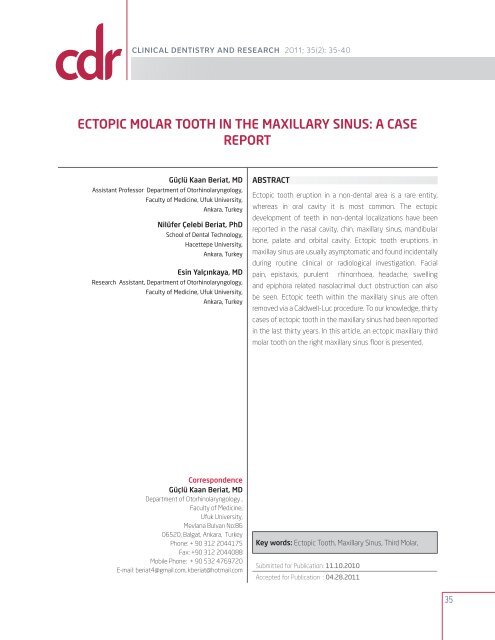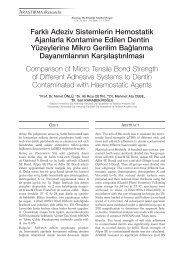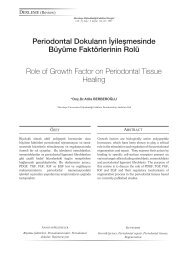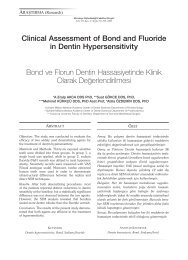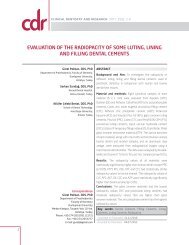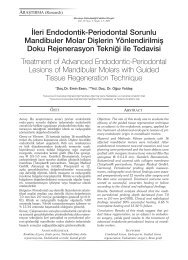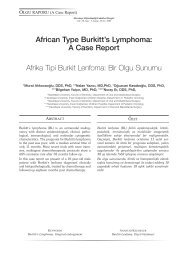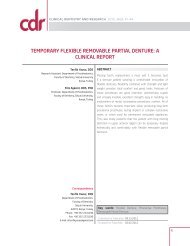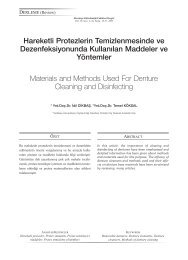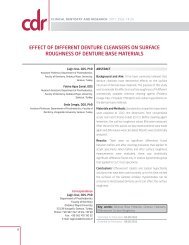ectopic molar tooth in the maxillary sinus - official publication of ...
ectopic molar tooth in the maxillary sinus - official publication of ...
ectopic molar tooth in the maxillary sinus - official publication of ...
You also want an ePaper? Increase the reach of your titles
YUMPU automatically turns print PDFs into web optimized ePapers that Google loves.
CLINICAL DENTISTRY AND RESEARCH 2011; 35(2): 35-40<br />
ECTOPIC MOLAR TOOTH IN THE MAXILLARY SINUS: A CASE<br />
REPORT<br />
Güçlü Kaan Beriat, MD<br />
Assistant Pr<strong>of</strong>essor Department <strong>of</strong> Otorh<strong>in</strong>olaryngology,<br />
Faculty <strong>of</strong> Medic<strong>in</strong>e, Ufuk University,<br />
Ankara, Turkey<br />
Nilüfer Çelebi Beriat, PhD<br />
School <strong>of</strong> Dental Technology,<br />
Hacettepe University,<br />
Ankara, Turkey<br />
Es<strong>in</strong> Yalçınkaya, MD<br />
Research Assistant, Department <strong>of</strong> Otorh<strong>in</strong>olaryngology,<br />
Faculty <strong>of</strong> Medic<strong>in</strong>e, Ufuk University,<br />
Ankara, Turkey<br />
Correspondence<br />
Güçlü Kaan Beriat, MD<br />
Department <strong>of</strong> Otorh<strong>in</strong>olaryngology ,<br />
Faculty <strong>of</strong> Medic<strong>in</strong>e,<br />
Ufuk University,<br />
Mevlana Bulvarı No:86<br />
06520, Balgat, Ankara, Turkey<br />
Phone: + 90 312 2044175<br />
Fax: +90 312 2044088<br />
Mobile Phone: + 90 532 4769720<br />
E-mail: beriat4@gmail.com, kberiat@hotmail.com<br />
ABSTRACT<br />
Ectopic <strong>tooth</strong> eruption <strong>in</strong> a non-dental area is a rare entity,<br />
whereas <strong>in</strong> oral cavity it is most common. The <strong>ectopic</strong><br />
development <strong>of</strong> teeth <strong>in</strong> non-dental localizations have been<br />
reported <strong>in</strong> <strong>the</strong> nasal cavity, ch<strong>in</strong>, <strong>maxillary</strong> s<strong>in</strong>us, mandibular<br />
bone, palate and orbital cavity. Ectopic <strong>tooth</strong> eruptions <strong>in</strong><br />
maxillay s<strong>in</strong>us are usually asymptomatic and found <strong>in</strong>cidentally<br />
dur<strong>in</strong>g rout<strong>in</strong>e cl<strong>in</strong>ical or radiological <strong>in</strong>vestigation. Facial<br />
pa<strong>in</strong>, epistaxis, purulent rh<strong>in</strong>orrhoea, headache, swell<strong>in</strong>g<br />
and epiphora related nasolacrimal duct obstruction can also<br />
be seen. Ectopic teeth with<strong>in</strong> <strong>the</strong> <strong>maxillary</strong> s<strong>in</strong>us are <strong>of</strong>ten<br />
removed via a Caldwell-Luc procedure. To our knowledge, thirty<br />
cases <strong>of</strong> <strong>ectopic</strong> <strong>tooth</strong> <strong>in</strong> <strong>the</strong> <strong>maxillary</strong> s<strong>in</strong>us had been reported<br />
<strong>in</strong> <strong>the</strong> last thirty years. In this article, an <strong>ectopic</strong> <strong>maxillary</strong> third<br />
<strong>molar</strong> <strong>tooth</strong> on <strong>the</strong> right <strong>maxillary</strong> s<strong>in</strong>us floor is presented.<br />
Key words: Ectopic Tooth, Maxillary S<strong>in</strong>us, Third Molar,<br />
Submitted for Publication: 11.10.2010<br />
Accepted for Publication : 04.28.2011<br />
35
36<br />
CLINICAL DENTISTRY AND RESEARCH<br />
INTRODUCTION<br />
Ectopic <strong>tooth</strong> eruption <strong>in</strong> a non-dental area is a rare entity,<br />
whereas <strong>in</strong> dental localization it is most common. The <strong>ectopic</strong><br />
development <strong>of</strong> teeth <strong>in</strong> non-dental localizations have been<br />
reported <strong>in</strong> <strong>the</strong> nasal cavity, ch<strong>in</strong>, <strong>maxillary</strong> s<strong>in</strong>us, mandibular<br />
bone, palate and orbital cavity. 1-3 The pathogenesis <strong>of</strong><br />
<strong>ectopic</strong> teeth are unknown. Authors believe that aetiology<br />
<strong>in</strong>cludes developmental disturbances such as cleft palate,<br />
trauma, r<strong>in</strong>ogenic or odontogenic <strong>in</strong>fection, genetic factors,<br />
crowd<strong>in</strong>g or dentigerous cysts surround<strong>in</strong>g impacted<br />
<strong>tooth</strong>. 4,5 Ectopic teeth may be permanent, deciduous or<br />
supernumerary. The <strong>maxillary</strong> can<strong>in</strong>e and mandibular third<br />
<strong>molar</strong> are <strong>in</strong>volved most frequently. 6,7 Most cases are<br />
asymptomatic and usually found <strong>in</strong>cidentally dur<strong>in</strong>g rout<strong>in</strong>e<br />
cl<strong>in</strong>ical or radiological <strong>in</strong>vestigation. Facial pa<strong>in</strong>, epistaxis,<br />
purulent rh<strong>in</strong>orrhoea, external nasal deformity, headache,<br />
swell<strong>in</strong>g and epiphora related nasolacrimal duct obstruction<br />
can be seen. 8, 9 The standard treatment for an <strong>ectopic</strong><br />
<strong>tooth</strong> is extraction <strong>of</strong> <strong>the</strong> <strong>tooth</strong>. 10 Ectopic teeth with<strong>in</strong> <strong>the</strong><br />
<strong>maxillary</strong> s<strong>in</strong>us are <strong>of</strong>ten easily removed via a Caldwell-Luc<br />
procedure. 11 In <strong>the</strong> <strong>ectopic</strong> teeth surround<strong>in</strong>g by a large<br />
cyst, an <strong>in</strong>itial marsupialization to dim<strong>in</strong>ish <strong>the</strong> size <strong>of</strong> <strong>the</strong><br />
osseous defect, followed by extraction <strong>of</strong> <strong>the</strong> <strong>tooth</strong>, has<br />
been advocated. 10,11<br />
In this paper, a case <strong>of</strong> an <strong>ectopic</strong> <strong>tooth</strong> <strong>in</strong> <strong>the</strong> <strong>maxillary</strong><br />
s<strong>in</strong>us is reported, and accord<strong>in</strong>gly a review <strong>of</strong> <strong>the</strong> Englishlanguage<br />
literature <strong>of</strong> <strong>the</strong> last thirty years is presented.<br />
CASE REPORT<br />
A 24-year-old woman was referred to us due to <strong>the</strong> pa<strong>in</strong><br />
on <strong>the</strong> right side <strong>of</strong> her face last<strong>in</strong>g for 1 year. Antibiotics<br />
and pa<strong>in</strong>-killers were prescribed to her by <strong>the</strong> general<br />
practitioner, but her compla<strong>in</strong>ts were not resolved. She had<br />
no o<strong>the</strong>r symptoms. Anterior rh<strong>in</strong>oscopy revealed a septal<br />
deviation towards left side. On exam<strong>in</strong>ation <strong>of</strong> <strong>the</strong> oral<br />
cavity, all <strong>the</strong> permanent teeth were present except <strong>the</strong><br />
right <strong>maxillary</strong> third <strong>molar</strong>. No o<strong>the</strong>r pathological f<strong>in</strong>d<strong>in</strong>gs<br />
were detected as a result <strong>of</strong> <strong>in</strong>traoral and nasal endoscopic<br />
exam<strong>in</strong>ations. Coronal computed tomography (CT) <strong>of</strong> <strong>the</strong><br />
paranasal s<strong>in</strong>uses revealed <strong>the</strong> presence <strong>of</strong> an <strong>ectopic</strong> <strong>molar</strong><br />
<strong>tooth</strong> with<strong>in</strong> right <strong>maxillary</strong> s<strong>in</strong>us floor, and septal nasal spur<br />
at left nasal cavity (Figure 1).<br />
Caldwell-Luc operation on <strong>the</strong> right side and septoplasty<br />
were performed under general anes<strong>the</strong>sia. Right naso<strong>maxillary</strong><br />
w<strong>in</strong>dow was opened (Figure 2). Tooth was<br />
removed from <strong>maxillary</strong> s<strong>in</strong>us floor by burr (Figure 3).<br />
Figure 1. Coronal image <strong>of</strong> paranasal s<strong>in</strong>uses show <strong>the</strong> area <strong>of</strong> high<br />
attenuation on <strong>the</strong> floor <strong>of</strong> <strong>the</strong> right <strong>maxillary</strong> s<strong>in</strong>us.<br />
Figure 2. Intraoperative photograph <strong>of</strong> <strong>the</strong> <strong>tooth</strong> <strong>in</strong> <strong>the</strong> <strong>maxillary</strong><br />
s<strong>in</strong>us.<br />
The patient’s symptoms were resolved completely after<br />
surgery and rema<strong>in</strong>ed symptom-free for over a postoperative<br />
follow-up period <strong>of</strong> 1 year.<br />
DISCUSSION<br />
Tooth evolution results from an <strong>in</strong>teraction between <strong>the</strong><br />
oral epi<strong>the</strong>lium and <strong>the</strong> underly<strong>in</strong>g mesenchymal tissue.<br />
This development beg<strong>in</strong>s <strong>in</strong> <strong>the</strong> sixth week <strong>in</strong> utero at <strong>the</strong><br />
time <strong>of</strong> maxillar and mandibular dental lam<strong>in</strong>a formation.<br />
This ectodermal structure changes to mature form <strong>in</strong>clud<strong>in</strong>g<br />
a crown and a root. 12 Abnormal tissue <strong>in</strong>teractions dur<strong>in</strong>g
Figure 3. View <strong>of</strong> <strong>the</strong> excised <strong>tooth</strong>.<br />
development may result <strong>in</strong> <strong>ectopic</strong> <strong>tooth</strong> development and<br />
eruption. Commonly <strong>ectopic</strong> eruption <strong>of</strong> a <strong>tooth</strong> occurs <strong>in</strong><br />
<strong>the</strong> oral cavity and essentially <strong>in</strong> normal position but rare<br />
localizations like nasal septum, mandibular condyle, coronoid<br />
process, palate and <strong>maxillary</strong> s<strong>in</strong>us has been reported. 13 The<br />
<strong>maxillary</strong> can<strong>in</strong>e and mandibular third <strong>molar</strong> are <strong>in</strong>volved<br />
most frequently. In this paper, a case <strong>of</strong> a <strong>maxillary</strong> third<br />
<strong>molar</strong> <strong>tooth</strong>, which was <strong>ectopic</strong>ally located <strong>in</strong> <strong>the</strong> <strong>maxillary</strong><br />
s<strong>in</strong>us was reported.<br />
The Pubmed and Medl<strong>in</strong>e databases <strong>in</strong> <strong>the</strong> English-language<br />
literature published s<strong>in</strong>ce 1980 on <strong>ectopic</strong> teeth located <strong>in</strong><br />
<strong>the</strong> <strong>maxillary</strong> s<strong>in</strong>us were reviewed. To our knowledge, only<br />
30 cases has been reported until 2010. 1,3,6,7,9,13-24<br />
Ectopic teeth, are commonly observed <strong>in</strong> <strong>the</strong> second or<br />
third decade <strong>of</strong> life. 3 The age range <strong>of</strong> <strong>the</strong> reported 30<br />
cases varies from 4 to 57. The mean age <strong>of</strong> <strong>the</strong> previously<br />
reported cases was 28.06 years. The <strong>in</strong>cidence is higher <strong>in</strong><br />
men than <strong>in</strong> women. Our patient was a 24-year old woman.<br />
Ectopic teeth are supposed to be related to embryological<br />
pathologies such as clefts, fusion deficiencies or cyst<br />
formations. 16 O<strong>the</strong>r pathogenetic factors suggested for<br />
<strong>ectopic</strong> <strong>tooth</strong> formation ethiology are obstruction caused by<br />
supernumerous teeth formation, developmental disorders,<br />
rh<strong>in</strong>ogenic or odontogenic <strong>in</strong>fections, or misplacements<br />
related to trauma or cysts. 22<br />
In <strong>the</strong> present review, 18 <strong>of</strong> <strong>the</strong> previous cases had a<br />
<strong>molar</strong> <strong>tooth</strong>, five <strong>of</strong> which had a can<strong>in</strong>e <strong>tooth</strong>, three had a<br />
supernumerary, and one had a pre<strong>molar</strong> <strong>tooth</strong>, one had an<br />
odontoma, and one had a <strong>tooth</strong> like structure. Seventeen<br />
<strong>of</strong> <strong>the</strong> <strong>molar</strong> teeth were third <strong>molar</strong>, only one <strong>of</strong> which<br />
was a second <strong>molar</strong> <strong>tooth</strong>. The case presented was a third<br />
"SecOnD MOlAR TOOTH eMbeDDeD <strong>in</strong> THe MAxillARy S<strong>in</strong>US"<br />
<strong>molar</strong> <strong>tooth</strong>, which is found to be <strong>the</strong> mostly studied one <strong>in</strong><br />
literature.<br />
Frequently <strong>ectopic</strong> teeth are asymptomatic and are usually<br />
found dur<strong>in</strong>g rout<strong>in</strong>e cl<strong>in</strong>ical or radiologic <strong>in</strong>vestigations. 17 If<br />
<strong>the</strong> <strong>tooth</strong> erupts <strong>in</strong>to <strong>the</strong> <strong>maxillary</strong> antrum, it can present<br />
itself with local s<strong>in</strong>onasal symptoms like nasal obstruction,<br />
facial fullness, headache, hyposmia and recurrent choronic<br />
s<strong>in</strong>usitis. O<strong>the</strong>r rare symptoms <strong>in</strong>clude epistaxis, fever,<br />
rh<strong>in</strong>orrhea, nasolacrimal duct obstruction and a deviation<br />
<strong>of</strong> <strong>the</strong> naso<strong>maxillary</strong> anatomy. 22,23 A large <strong>maxillary</strong> cyst<br />
can exert pressure on <strong>the</strong> s<strong>in</strong>us walls caus<strong>in</strong>g discomfort,<br />
pa<strong>in</strong> and fullness. 24 Scored symptomatology helps us to<br />
consider <strong>the</strong> presence <strong>of</strong> an <strong>ectopic</strong> <strong>tooth</strong> but a radiographic<br />
exam<strong>in</strong>ation is essential for diagnosis. Among <strong>the</strong> 30 case<br />
reports summarized <strong>in</strong> Table 1. 12 patients compla<strong>in</strong>ed<br />
<strong>of</strong> swell<strong>in</strong>g, 5 <strong>of</strong> nasal obstruction, 5 <strong>of</strong> rh<strong>in</strong>orrhoea, 4 <strong>of</strong><br />
headache, 2 <strong>of</strong> epiphora, and only one patient compla<strong>in</strong>ed <strong>of</strong><br />
orbital proptosis. Six patients were asymptomatic and were<br />
noticed <strong>in</strong>cidentally on radiologic exam<strong>in</strong>ation. Our patient<br />
was referred to us for a pa<strong>in</strong> <strong>of</strong> one year duration on <strong>the</strong><br />
right side <strong>of</strong> her face.<br />
The diagnosis <strong>of</strong> this conduction can be made radiographically<br />
with pla<strong>in</strong> s<strong>in</strong>us X-rays and CT scans taken <strong>in</strong> axial and<br />
coronal sections. Water’s view, panoramic radiography and<br />
pla<strong>in</strong> skull radiography are simple and relatively <strong>in</strong>expensive<br />
methods. Although conventional radiography can be used<br />
<strong>in</strong> detect<strong>in</strong>g <strong>the</strong> structure <strong>of</strong> <strong>the</strong> <strong>tooth</strong>, CT imag<strong>in</strong>g is gold<br />
standard for determ<strong>in</strong><strong>in</strong>g <strong>the</strong> exact localization. 18 In <strong>the</strong><br />
case studied, CT was performed for paranasal <strong>in</strong>spection.<br />
In <strong>the</strong> coronal section, a radiopaque image, which had an<br />
equal density with <strong>the</strong> <strong>tooth</strong> was seen <strong>in</strong> <strong>the</strong> <strong>in</strong>ferior <strong>of</strong> <strong>the</strong><br />
<strong>maxillary</strong> s<strong>in</strong>us.<br />
Foreign bodies (rh<strong>in</strong>olits), <strong>in</strong>fections like syphilis, tuberculosis<br />
or fungal <strong>in</strong>fections with calcification, benign lesions such<br />
as hemangioma, osteoma, enchondroma, calcified polyp,<br />
dermoid cysts or tumors, and malignant lesions such as<br />
chondrosarcoma, osteosarcoma must be considered <strong>in</strong> <strong>the</strong><br />
differential diagnosis <strong>of</strong> <strong>ectopic</strong> teeth. In CT scan, a density<br />
equal to that <strong>of</strong> <strong>the</strong> <strong>tooth</strong> and a central cavity <strong>in</strong> <strong>the</strong> mass<br />
are <strong>the</strong> f<strong>in</strong>d<strong>in</strong>gs for <strong>the</strong> diagnosis <strong>of</strong> <strong>ectopic</strong> <strong>tooth</strong> or<br />
dentigerous cysts. 22<br />
When a <strong>maxillary</strong> s<strong>in</strong>us <strong>tooth</strong> or cyst causes symptoms,<br />
surgery must be considered. The traditional approach is<br />
Caldwell-Luc procedure, which allows a direct view <strong>in</strong>to <strong>the</strong><br />
<strong>maxillary</strong> s<strong>in</strong>us. Although this is <strong>the</strong> classical treatment,<br />
transnasal endoscopic approach has less morbidity. 24<br />
37
38<br />
CLINICAL DENTISTRY AND RESEARCH<br />
Table 1. Literature review <strong>of</strong> <strong>ectopic</strong> teeth <strong>in</strong> <strong>the</strong> <strong>maxillary</strong> s<strong>in</strong>us <strong>in</strong> previous reports.<br />
Author Age Gender Composition Symptom<br />
Localization <strong>in</strong><br />
<strong>the</strong> <strong>maxillary</strong><br />
s<strong>in</strong>us<br />
Treatment<br />
Golden et al, 1981 37 Female Molar <strong>tooth</strong> no symptom Ro<strong>of</strong> caldwell-luc operation<br />
chuong , 1984 16 Male Molar <strong>tooth</strong> no symptom<br />
Freedland and<br />
Henneman, 1987<br />
21 Female<br />
Supernumerary<br />
<strong>tooth</strong><br />
Shenoy, 1988 28 Male can<strong>in</strong>e <strong>tooth</strong><br />
İntermittent headache<br />
Swell<strong>in</strong>g, nasal<br />
obstruction<br />
elango et al, 1991 23 Male Molar <strong>tooth</strong> Asymptomatic Ro<strong>of</strong><br />
Jude et al, 1995 42 Male Molar <strong>tooth</strong> Facial asymmetry<br />
Vele et al, 1996 17 Male<br />
Supernumerary<br />
<strong>tooth</strong><br />
Altas et al, 1997 41 Male can<strong>in</strong>e <strong>tooth</strong><br />
Swell<strong>in</strong>g<br />
Swell<strong>in</strong>g,nasal<br />
obstruction, epiphora<br />
bodner et al, 1997 51 Female Molar <strong>tooth</strong> Asymptomatic<br />
bodner et al, 1997 25 Male Molar <strong>tooth</strong><br />
bodner et al, 1997 40 Female Molar <strong>tooth</strong><br />
Takagi and Koyama,<br />
1998<br />
erkmen et al, 1998 11 Male<br />
Discomfort <strong>in</strong> <strong>the</strong><br />
<strong>maxillary</strong> region<br />
6 Female Pre<strong>molar</strong> <strong>tooth</strong> Swell<strong>in</strong>g<br />
Supernumerary<br />
<strong>tooth</strong><br />
Hasb<strong>in</strong>i et al, 2001 21 Male Molar <strong>tooth</strong><br />
Goh ,2001 17 Male Molar <strong>tooth</strong><br />
Kamei et al,2001 38 Female Molar <strong>tooth</strong><br />
bajaj et al, 2003 21 Male<br />
Ustuner et al, 2003 6 Male<br />
Tooth-like<br />
structure<br />
bilateral <strong>ectopic</strong><br />
teeth<br />
Sharma et al, 2006 40 Female can<strong>in</strong>e <strong>tooth</strong><br />
Di Pasquale and<br />
Shermataro, 2006<br />
Sr<strong>in</strong>ivasa et al,<br />
2007<br />
Disappeared<br />
iatrogenically dur<strong>in</strong>g<br />
extraction<br />
Facial pa<strong>in</strong>, purulent<br />
rh<strong>in</strong>orrhea<br />
nasal obstruction,<br />
headache, hypoosmia<br />
Facial pa<strong>in</strong>, purulent<br />
nasal discharge<br />
Facial pa<strong>in</strong>, nasal<br />
obstruction, rh<strong>in</strong>orrhea<br />
Antrum, medial<br />
wall<br />
Antrum, medial<br />
wall<br />
Antrum,medial<br />
,wall<br />
Antrum, medial<br />
wall<br />
Antrum, medial<br />
wall<br />
Antrum, medial<br />
wall<br />
Antrum, medial<br />
wall<br />
Antrum, medial<br />
wall<br />
Antrum, medial<br />
wall<br />
Antrum, medial<br />
wall<br />
Floor<br />
Swell<strong>in</strong>g, epiphora Ro<strong>of</strong><br />
Swell<strong>in</strong>g<br />
Facial pa<strong>in</strong>, purulent<br />
nasal discharge<br />
14 Female Molar <strong>tooth</strong> Asymptomatic<br />
45 Male Molar <strong>tooth</strong><br />
Swell<strong>in</strong>g, pa<strong>in</strong>, purulent<br />
rh<strong>in</strong>oorhea<br />
Antrum, medial<br />
wall<br />
Antrum, medial<br />
wall<br />
not attached to<br />
<strong>the</strong> wall<br />
Superiomedial<br />
wall<br />
Antrum, medial<br />
wall<br />
Antrum,medial<br />
wall<br />
Antrum, medial<br />
wall<br />
caldwell-luc operation<br />
enucleation<br />
caldwell-luc operation<br />
Follow-up<br />
recommended<br />
endoscopic S<strong>in</strong>us<br />
Surgery<br />
caldwell-luc operation<br />
caldwell-luc operation<br />
Crestal İncision<br />
caldwell-luc operation<br />
caldwell-luc operation<br />
Marsupialization<br />
Follow-up<br />
recommended<br />
endoscopic S<strong>in</strong>us<br />
Surgery<br />
caldwell-luc operation<br />
caldwell-luc operation<br />
Marsupialization,<br />
dacryocystorh<strong>in</strong>ostomy<br />
Unspesified<br />
caldwell-luc operation<br />
endoscopic S<strong>in</strong>us<br />
Surgery<br />
caldwell-luc operation
Author Age Gender Composition Symptom<br />
Transnasal procedure may be useful for teeth around<br />
<strong>maxillary</strong> antrum. Accord<strong>in</strong>g to Table 1, <strong>the</strong> most common<br />
approach (<strong>in</strong> 18 cases) is Caldwell-Luc procedure. Five<br />
patients were treated with endoscopic s<strong>in</strong>us surgery, 3 with<br />
marsupialization, 2 with crestal <strong>in</strong>cision, and enucleation<br />
method was used for only one patient. In <strong>the</strong> present case,<br />
Caldwell-Luc operation was performed to remove <strong>the</strong> <strong>tooth</strong><br />
from <strong>maxillary</strong> s<strong>in</strong>us. Maxillary s<strong>in</strong>us was viewed through<br />
<strong>the</strong> bony w<strong>in</strong>dow, s<strong>in</strong>us mucosa was normal, no pathologic<br />
secretion existed, floor <strong>of</strong> <strong>the</strong> s<strong>in</strong>us was <strong>in</strong>tact and <strong>the</strong>re<br />
was not any complication caused by <strong>the</strong> <strong>ectopic</strong> <strong>tooth</strong>. The<br />
removed material was a mature <strong>tooth</strong> so no histopathologic<br />
exam<strong>in</strong>ation was required. The patient rema<strong>in</strong>ed symptomfree<br />
over a postoperative period <strong>of</strong> one year.<br />
To our knowledge, <strong>the</strong> localization <strong>of</strong> <strong>the</strong> <strong>ectopic</strong> <strong>tooth</strong><br />
<strong>in</strong> <strong>the</strong> <strong>maxillary</strong> s<strong>in</strong>us was not analyzed <strong>in</strong> <strong>the</strong> previous<br />
literature. As seen <strong>in</strong> <strong>the</strong> Table 1, medial wall and <strong>the</strong> antral<br />
area are <strong>the</strong> most common localization cases among <strong>the</strong><br />
30 reported ones. In 6 cases, <strong>the</strong> teeth were located on<br />
<strong>the</strong> ro<strong>of</strong> <strong>of</strong> <strong>the</strong> s<strong>in</strong>us, 4 <strong>of</strong> which were on <strong>the</strong> floor, 1 on<br />
<strong>the</strong> lateral wall, 1 was placed superiomedially, 1 was placed<br />
posteriosuperiorly and one <strong>of</strong> <strong>the</strong>m was not attached to <strong>the</strong><br />
s<strong>in</strong>us walls. The presented case is <strong>the</strong> fifth <strong>maxillary</strong> s<strong>in</strong>us<br />
<strong>tooth</strong> localizated on <strong>the</strong> s<strong>in</strong>us floor, reported <strong>in</strong> <strong>the</strong> English-<br />
"SecOnD MOlAR TOOTH eMbeDDeD <strong>in</strong> THe MAxillARy S<strong>in</strong>US"<br />
language data base <strong>in</strong> <strong>the</strong> last 30 years. The high range <strong>of</strong><br />
antral localization may be due to <strong>in</strong>creased symptomatology.<br />
Asymptomatic <strong>ectopic</strong> teeth are estimated to have a higher<br />
<strong>in</strong>cidence but it is difficult to determ<strong>in</strong>e <strong>the</strong> exact ratio.<br />
REFERENCES<br />
Localization <strong>in</strong><br />
<strong>the</strong> <strong>maxillary</strong><br />
s<strong>in</strong>us<br />
Treatment<br />
Altun et al, 2007 30 Male Molar <strong>tooth</strong> Headache lateral wall caldwell-luc operation<br />
Avitia et al, 2007 49 Male Molar <strong>tooth</strong><br />
Micozkadioglu and<br />
erkan, 2007<br />
Dagistan et al,<br />
2007<br />
24 Female Molar <strong>tooth</strong><br />
nasal obstruction,<br />
orbital proptosis<br />
Swell<strong>in</strong>g, facial pa<strong>in</strong>,<br />
headache<br />
Posteriosuperior<br />
wall<br />
Floor<br />
endoscopic S<strong>in</strong>us<br />
Surgery<br />
endoscopic S<strong>in</strong>us<br />
Surgery<br />
37 Male can<strong>in</strong>e <strong>tooth</strong> Asymptomatic Floor caldwell-luc operation<br />
Haber, 2008 4 Female Odontoma Swell<strong>in</strong>g, facial pa<strong>in</strong> Floor caldwell-luc operation<br />
litv<strong>in</strong> et al, 2008 57 Female Molar <strong>tooth</strong> Swell<strong>in</strong>g Ro<strong>of</strong><br />
buyukkurt et<br />
al,2010<br />
buyukkurt et<br />
al,2010<br />
buyukkurt et<br />
al,2010<br />
caldwell-luc operation,<br />
marsupialization<br />
19 Female Molar <strong>tooth</strong> Swell<strong>in</strong>g Ro<strong>of</strong> caldwell-luc operation<br />
32 Male can<strong>in</strong>e <strong>tooth</strong> Swell<strong>in</strong>g Ro<strong>of</strong> caldwell-luc operation<br />
30 Male Molar <strong>tooth</strong> Swell<strong>in</strong>g Antrum caldwell luc operation<br />
1. Erkmen N, Olmez S, Onerci M. Supernumerary <strong>tooth</strong> <strong>in</strong> <strong>the</strong><br />
<strong>maxillary</strong> s<strong>in</strong>us: case report. Aust Dent J 1998; 43: 385-386.<br />
2. Gulbranson SH, Wolfrey JD, Ra<strong>in</strong>es JM, McNally BP. SquaMous<br />
cell carc<strong>in</strong>oma aris<strong>in</strong>g <strong>in</strong> a Dentigerous cyst <strong>in</strong> a16-month old girl.<br />
Otolaryngol Head Neck Surg 2002; 127: 463-464.<br />
3. Ustuner E, Fitoz S, Atasoy C, Erden I, Akyar S. Bilateral <strong>maxillary</strong><br />
Dentigerous cysts: a case report. Oral Surg Oral Med Oral Pathol Oral<br />
Radiol Endod 2003; 95: 632-635.<br />
4. Smith JL II, Kellman RM. Dentigerous cysts present<strong>in</strong>g as head and<br />
neck <strong>in</strong>fections. Otolaryngol Head Neck Surg 2005; 133: 715-717.<br />
5. Tournas AS, Tevfik MA, Chauv<strong>in</strong> PJ, Manoukian JJ. Multiple<br />
unilateral <strong>maxillary</strong> Dentigerous cysts <strong>in</strong> a non syndromic<br />
patient: A case report and review <strong>of</strong> <strong>the</strong> literature. Int J Pediatr<br />
Otorh<strong>in</strong>olaryngol 2006; 1: 100-106.<br />
6. Takagi S, Koyama S. Guided eruption <strong>of</strong> an impacted second<br />
pre<strong>molar</strong> associated with a Dentigerous cyst <strong>in</strong> <strong>the</strong> <strong>maxillary</strong> s<strong>in</strong>us<br />
<strong>of</strong> a 6-year-old child. J Oral Maxill<strong>of</strong>ac Surg 1998; 56: 237-239.<br />
39
40<br />
CLINICAL DENTISTRY AND RESEARCH<br />
7. Avitia S, Hamilton JS, Osborne RF. Dentigerous cyst present<strong>in</strong>g<br />
as orbital proptosis. Ear Nose Throat J 2007; 86: 23-24.<br />
8. Edamatsu M, Kumamoto H, Ooya K, Echigo S. Apoptosis related<br />
factors <strong>in</strong> <strong>the</strong> epi<strong>the</strong>lial components <strong>of</strong> dental follicles and<br />
Dentigerous cysts associated with impacted third <strong>molar</strong>s <strong>of</strong> <strong>the</strong><br />
mandible. Oral Surg Oral Med Oral Pathol Oral Radiol Endod 2005;<br />
99: 17-23.<br />
9. Freedland ES, Henneman PL. An unusual cause <strong>of</strong> headache: a<br />
Dentigerous cyst <strong>in</strong> <strong>the</strong> <strong>maxillary</strong> s<strong>in</strong>us. Ann Emerg Med 1987; 16:<br />
1174-1176.<br />
10. Martínez-Pérez D, Varela-Morales M. Conservative treatment<br />
<strong>of</strong> Dentigerous cysts <strong>in</strong> children: a report <strong>of</strong> 4 cases. J Oral Maxill<strong>of</strong>ac<br />
Surg 2001; 59: 331-333.<br />
11. Litv<strong>in</strong> M, Caprice D, Infranco L. Dentigerous cyst <strong>of</strong> <strong>the</strong> maxilla<br />
with impacted <strong>tooth</strong> displaced <strong>in</strong>to orbital rim and floor. Ear Nose<br />
Throat J 2008; 87: 160-162.<br />
12. Avery JK, editor. Oral Development and Histology. 2nd ed. New<br />
York: Thieme Medical Publisher Inc; 1994.<br />
13. Sr<strong>in</strong>ivasa Prasad T, Sujatha G, Thanvir Mohammad Niazi, Rajesh<br />
P. Dentrigerous cyst associated with an <strong>ectopic</strong> third <strong>molar</strong> <strong>in</strong> <strong>the</strong><br />
<strong>maxillary</strong> s<strong>in</strong>us: A rare entity. Indian J Dent Res 2007; 18: 141-143.<br />
14. Buyukkurt MC, Omezli MM, Miloglu O. Dentigerous cysts<br />
associated with an <strong>ectopic</strong> <strong>tooth</strong> <strong>in</strong> <strong>the</strong> <strong>maxillary</strong> s<strong>in</strong>us: a report <strong>of</strong><br />
3 cases and review <strong>of</strong> <strong>the</strong> literature. Oral Surg Oral Med Oral Pathol<br />
Oral Radiol Endod 2010; 109: 67-71.<br />
15. Shenoy P, Paulose KO, Al Khalifa S, Sharma RK. Odontogenic<br />
keratocyst <strong>in</strong>volv<strong>in</strong>g <strong>the</strong> <strong>maxillary</strong> antrum. J Laryngol Otol 1988;<br />
102: 1168-1171.<br />
16. Elango S, Palaniappan SP. Ectopic <strong>tooth</strong> <strong>in</strong> <strong>the</strong> ro<strong>of</strong> <strong>of</strong> <strong>the</strong><br />
<strong>maxillary</strong> s<strong>in</strong>us. Ear Nose Thorat J 1991; 70: 365-366.<br />
17. Jude R, Horowitz J, Loree T. A case report. Ectopic <strong>molar</strong>s that<br />
cause osteomeatal complex obstruction. J Am Dent Assoc 1995;<br />
126: 1655-1657.<br />
18. Bodner L, Tovi F, Bar-Ziv J. Teeth <strong>in</strong> <strong>the</strong> <strong>maxillary</strong> s<strong>in</strong>us-imag<strong>in</strong>g<br />
and management. J Laryngol Otol 1997; 111: 820-824.<br />
19. Goh YH. Ectopic eruption <strong>of</strong> <strong>maxillary</strong> <strong>molar</strong> <strong>tooth</strong>: an unusual<br />
cause <strong>of</strong> recurrent s<strong>in</strong>usitis. S<strong>in</strong>gapore Med J 2001; 42: 80-81.<br />
20. Kamei T, Inui M, Nakamura S, Tagawa T. Bony ossicle <strong>in</strong> <strong>the</strong><br />
<strong>maxillary</strong> s<strong>in</strong>us conta<strong>in</strong><strong>in</strong>g a <strong>tooth</strong>. J Oral Maxill<strong>of</strong>ac Surg 2001; 59:<br />
1108-1111.<br />
21. Sharma V, Lavania A, Mallick SA, Sharma M. Ectopic can<strong>in</strong>e<br />
<strong>tooth</strong>: a rare cause for <strong>maxillary</strong> antral mucocoele. Kathmandu Univ<br />
Med J 2006; 4: 251-252.<br />
22. Altun H, Teker AM, Ceran M, Gedikli O. Ectopic <strong>molar</strong> <strong>tooth</strong> <strong>in</strong><br />
<strong>the</strong> <strong>maxillary</strong> s<strong>in</strong>us. Kulak Burun Bogaz Ihtis Derg 2007; 17: 237-<br />
238.<br />
23. Hasb<strong>in</strong>i AS, Hadi U, Ghafari J. Endoscopic removal <strong>of</strong> an <strong>ectopic</strong><br />
third <strong>molar</strong> obstruct<strong>in</strong>g <strong>the</strong> osteomeatal complex. ear Nose Thorat<br />
J 2001; 80: 667-670.<br />
24. Di Pasquale P, Shermetaro C. Endoscopic removal <strong>of</strong> a<br />
Dentigerous cyst produc<strong>in</strong>g unilateral <strong>maxillary</strong> s<strong>in</strong>us opacification<br />
on computed tomography. Ear Nose Throat J 2006; 85: 747-748.


